Introduction
- Cancer occurs in the cervix;
- Major risk factor – HPV;
- Not all cases of HPV lead to cervical cancer;
- Worldwide:
- The “fourth most common malignancy” (Small et al., 2017, p. 2404);
- More than half a million new cases annually (Small et al., 2017);
- In the US:
- Cervical cancer takes up less than 1% of cancer cases;
- More than 65% of diagnosed patients survive five or more years (NCI, 2020).
Cervical cancer develops in the cervix – the lower part of the uterus. It starts in a particular part of the cervix, where its squamous and glandular cells connect. One of the factors that affect the occurrence of cervical cancer is human papillomavirus (HPV) (Marth et al., 2017). Although not all individuals with HPV get cervical cancer, certain viruses’ types cause the infection in the cervix. As a result, pre-cancerous changes include dysplasia of cells that can start and stop without turning into cancerous cells (Small et al., 2017). However, the cancerization of cells affected by the virus leads to cervical cancer.
This type of cancer disproportionally affects women in developing countries. According to Small et al. (2017), worldwide, cervical cancer is the “fourth most common malignancy” in female patients, and more than 80% of all deaths occur in underdeveloped or developing nations (p. 2404). In contrast, the rate of cervical cancer cases and deaths continues to decline in such developed countries as the United States. As the NCI (2020) finds, cervical cancer represents less than 1% of all cancer-related cases in the US. Furthermore, more than 65% of patients diagnosed with cervical cancer in the US survive for five or more years (NCI, 2020).
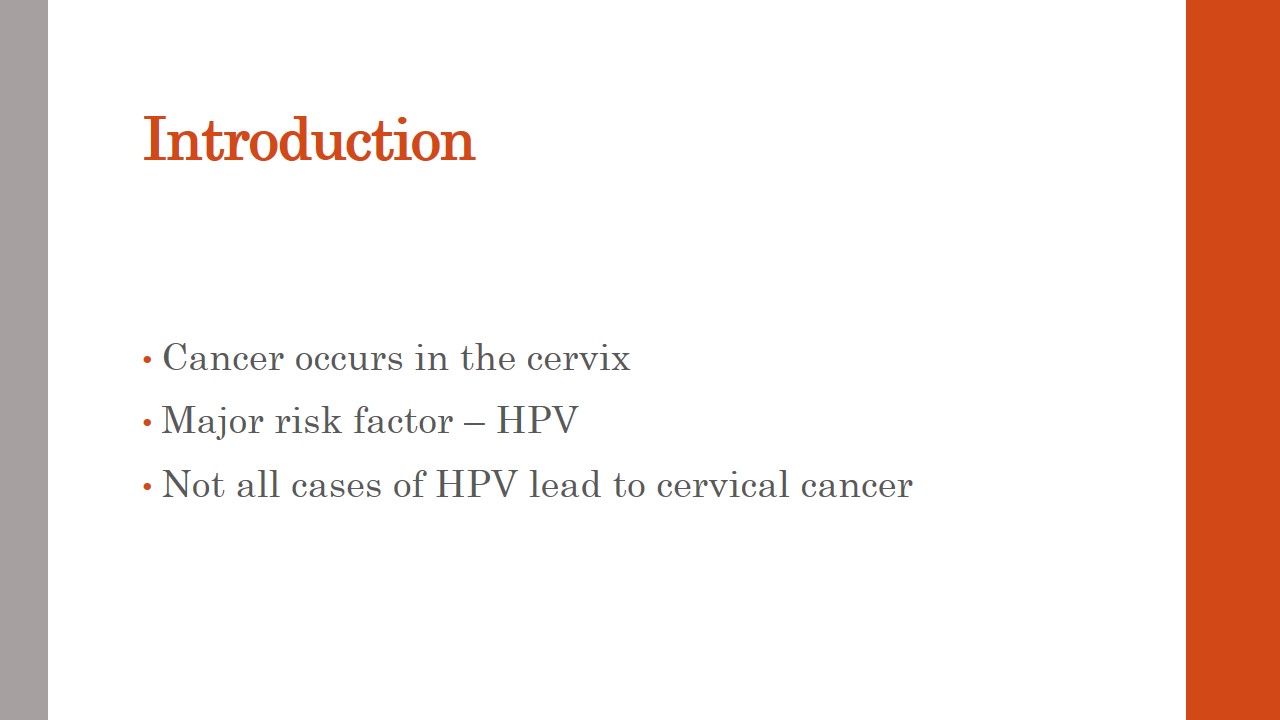

Clinical Assessment
- Abnormal cervical screening results.
- Abnormal vaginal bleeding.
- Pain during or after intercourse.
- Vaginal discharge.
In its early stages, cervical cancer can develop without any symptoms. One of the possible signs is abnormal vaginal bleeding that can occur between periods, during or after intercourse, or after the menopause (Marth et al., 2017). Second, pain during or after sexual intercourse is another symptom that may also radiate to the lower back or pelvis. Finally, another observable sign is a vaginal discharge, which may be bloody and have a foul odor. Nonetheless, the fourth and most reliable finding is the abnormal cervical screening result.
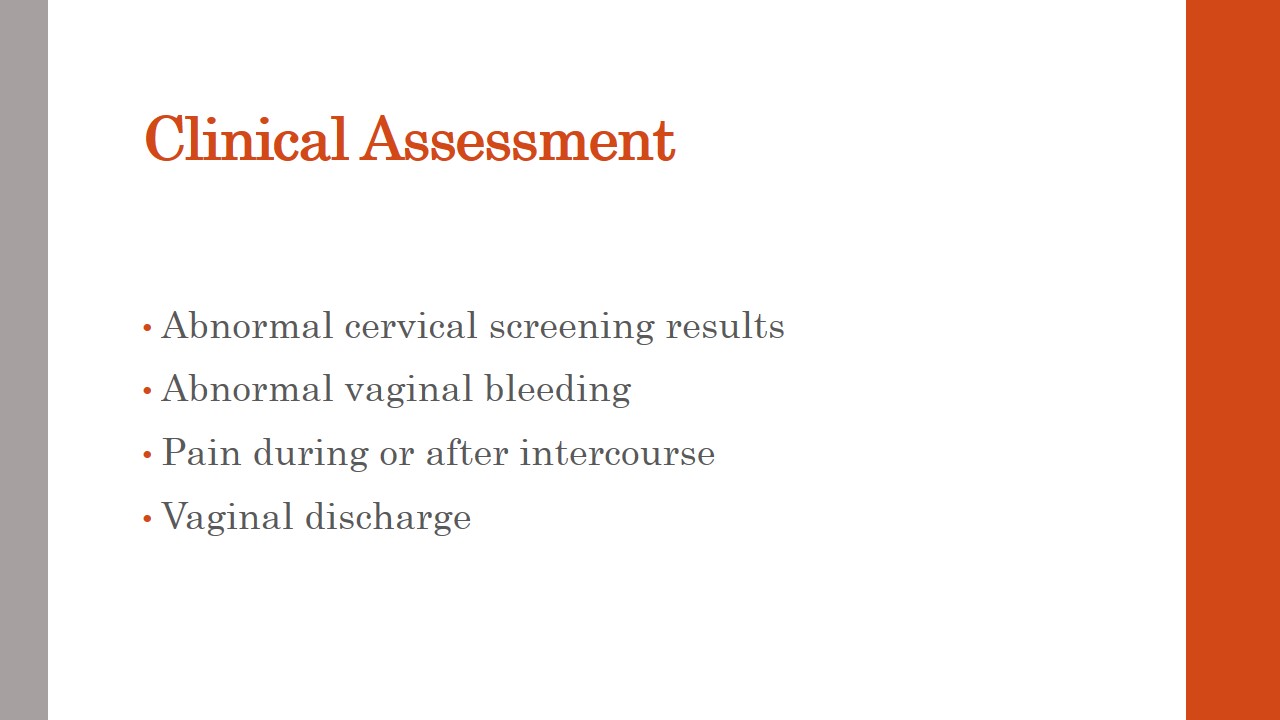
Clinical Assessment – Abnormal Results
- Pap-tests may show small abnormalities.
- First occurrences do not require additional testing.
- Repeat instances raise concerns.
A Pap test is the main screening procedure for detecting cervical cancer. The detection of changes in cervical cells is crucial to diagnosing cancer in its earliest stages. However, abnormal results of the test do not always signify the presence of cancer. Thus, clinicians have to be prepared to address this issue. For instance, women with abnormal results should be invited to a repeat Pap test and, in some cases, HPV test in a year or six months (Curry et al., 2018). Such findings as the atypical squamous cells of undetermined significance (ASCUS) are related to small abnormalities in cervical cells that are unlikely to be related to cancerous growth (Marth et al., 2017). It is recommended to repeat the test next year if this is the first abnormal result for the patient. If the patient’s tests already had similar findings in the past, the clinician may perform a colposcopy.
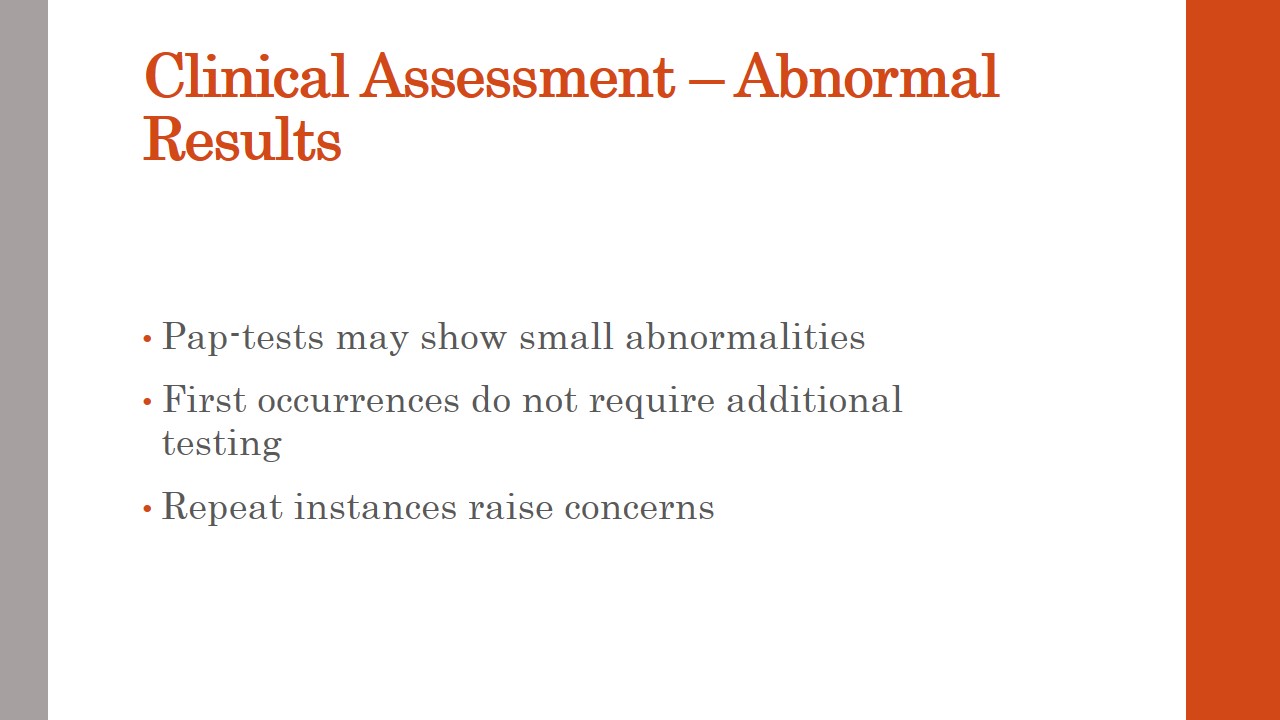
Differential Diagnosis
- Benign:
- Infection;
- Myoma;
- Polyp.
- Malignant:
- Bladder and rectal cancer;
- Metastases;
- Cervical sarcoma or lymphoma.
Differential diagnoses for cervical cancer can be both benign and malignant. Benign conditions include cervical infections (cervicitis), myomas, and polyps. In the majority of cases, these problems do not lead to cervical cancer. Cervicitis is an infection that has similar symptoms to those described previously, and it can be caused by a sexually transmitted infection (STI) or by cell overgrowth (Marth et al., 2017). It is treated with antibiotics depending on the cause of the disease. Myomas and polyps are usually not treated, but they can be surgically removed if necessary. Malignant conditions for differential diagnosis are cancers of other organs that are close to the cervix – rectal and bladder cancers (Marth et al., 2017). Metastases from tumors in other parts of the body, as well as cervical sarcoma or lymphoma, may also resemble cervical cancer.
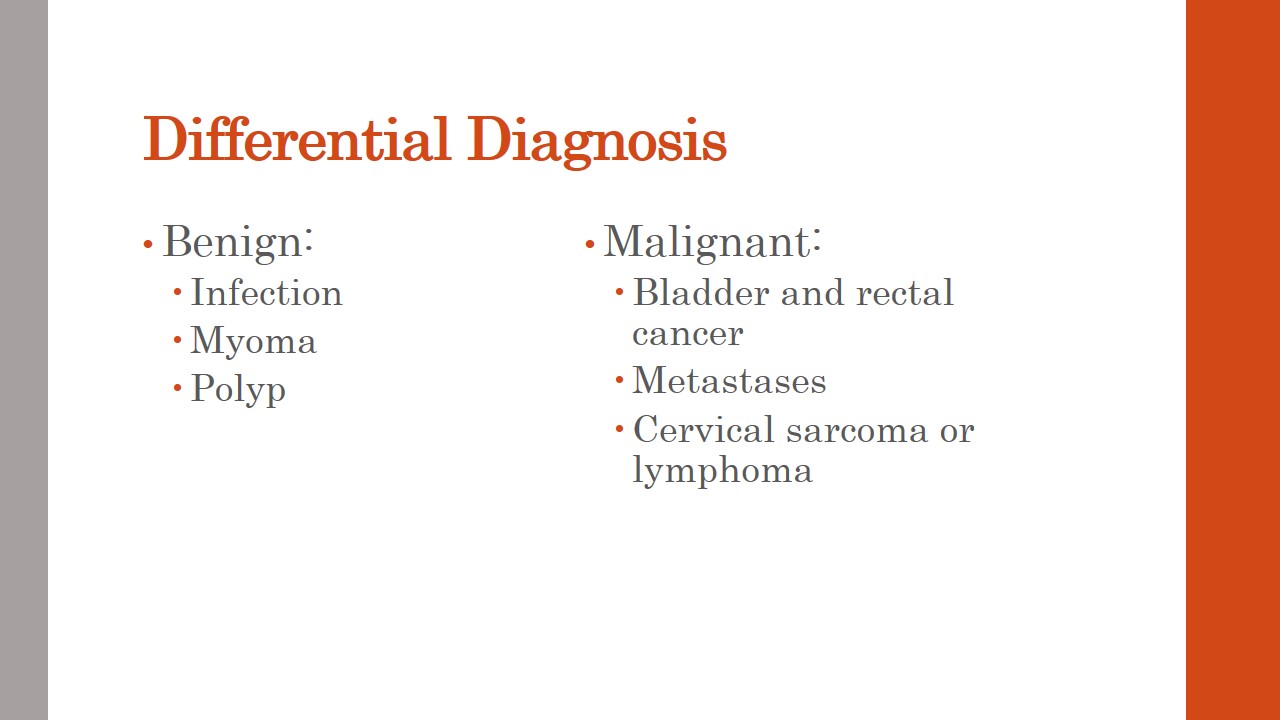
Diagnostic Studies and Laboratory Tests
- Colposcopy with a biopsy:
- Colposcopy biopsy;
- Endocervical curettage;
- Cone biopsy;
- Imaging tests:
- X-ray;
- CT;
- MRI;
- Cystoscopy.
- Proctoscopy.
When a Pap test shows some abnormal results that are more significant than ASCUS or a woman presents with symptoms, additional tests are needed to diagnose cancer and determine its stage. First of all, an examination of the cervix (colposcopy) is performed to inspect the surface of the cervix. Then, depending on the results of the colposcopy, the clinician performs a biopsy. Colposcopy biopsy is done when an abnormal area is observed – a small section of it is removed using forceps. If no abnormal areas are detected, one can perform an endocervical curettage – the endocervical canal is scraped to collect the sample. Cone biopsy is a more invasive procedure that requires anesthesia and can have negative effects on giving birth (Marth et al., 2017).
After a biopsy confirms the presence of cancer, further tests are required to determine the stage and spreading. These include chest x-ray, CT, or MRI to check for cancer spreading beyond the cervix (Marth et al., 2017). For large tumors, the clinician may also perform a cystoscopy or proctoscopy to inspect the bladder and rectum.
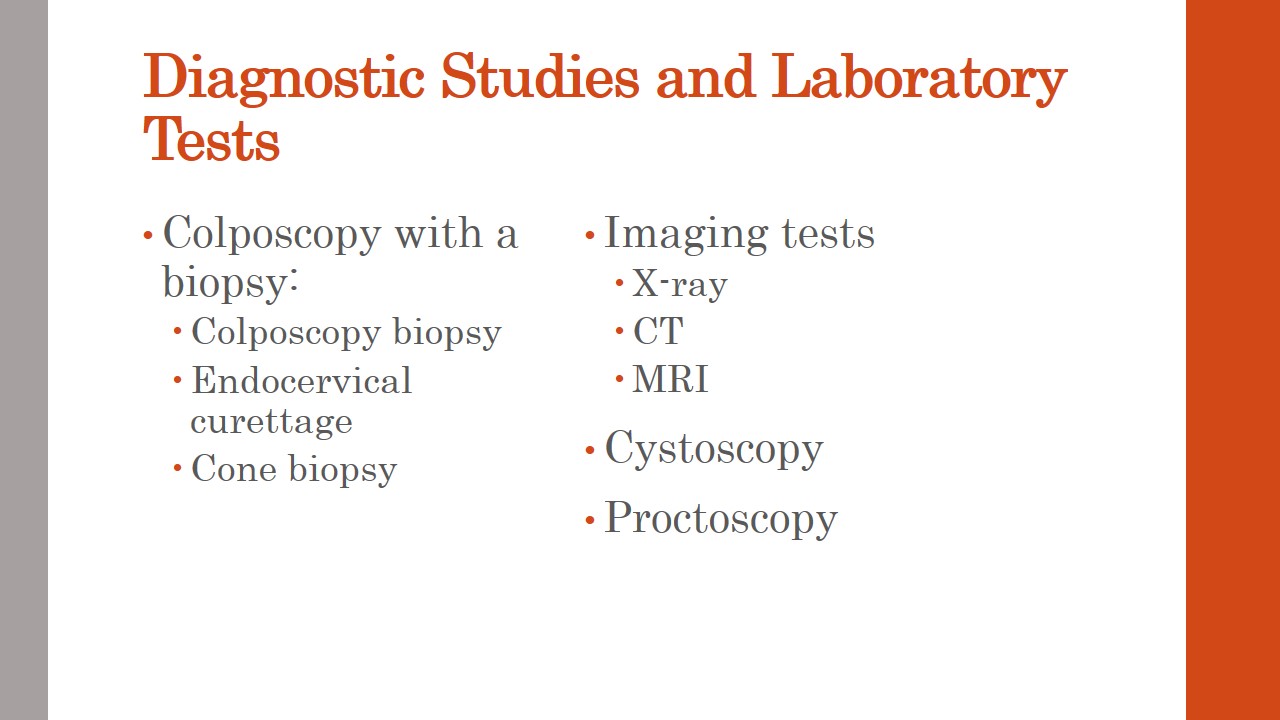
Prevention
- HPV vaccine.
- Safe sex.
- Not smoking.
The prevention of cervical cancer is directly linked to protecting oneself from HPV. The HPV vaccine is a major way of reducing the risk of infection and cancer (Musa et al., 2017). Vaccination starts at 11 years, but a person can get vaccinated until they turn 26. Unvaccinated patients who are 27 to 45 years old should discuss the possibility of vaccination, but the benefits of the vaccine are reduced at this stage. Next, one should limit their exposure to HPV by practicing safe sex and limiting the number of partners. Regular screening is another way of detecting any abnormalities early and stopping cancer from advancing. Finally, not smoking is another recommendation for preventing several cancer types (Musa et al., 2017).

Treatment
- Surgery:
- Cone biopsy;
- Radical trachelectomy;
- Simple or radical hysterectomy.
- Radiation therapy.
- Chemotherapy.
- Immunotherapy.
- Symptom management.
The choice greatly depends on cancer’s stage and the patient’s wishes. On stage IA1 (early detection, localized), removal is the first option. Cone biopsy and radical trachelectomy are performed on women who want to remain fertile, simple or radical hysterectomy are chosen for patients who do not want to maintain fertility (Marth et al., 2017). In later stages, radical surgical procedures are combined with radiation and chemotherapy. Radiation includes external radiation and brachytherapy, while chemotherapy may contain carboplatin, cisplatin, and cisplatin with fluorouracil (Marth et al., 2017). Immunotherapy and symptom management are added to support the patient.

Education
- HPV prevention and safe sex practices
- Regular screening recommendations
- Treatment options
- Resources for help and discussion
- Family education – support strategies
Patient and family education is vital for individuals with and without cancer. First, the clinician has to explain the significance of HPV prevention and regular screening to reduce the risk of cancer. Safe sex practices and the prevalence of HPV should be discussed to ensure that patients understand their role in their health. For women with abnormal results, additional information about benign and malignant changes need to be presented. Finally, for patients diagnosed with cervical cancer, it is essential to talk about treatment options, discuss fertility concerns, provide resources for mental health and support, and present the stories of people who survived cervical cancer. For families, the message of support is the central part of education since patients receiving a cancer diagnosis are under significant stress.
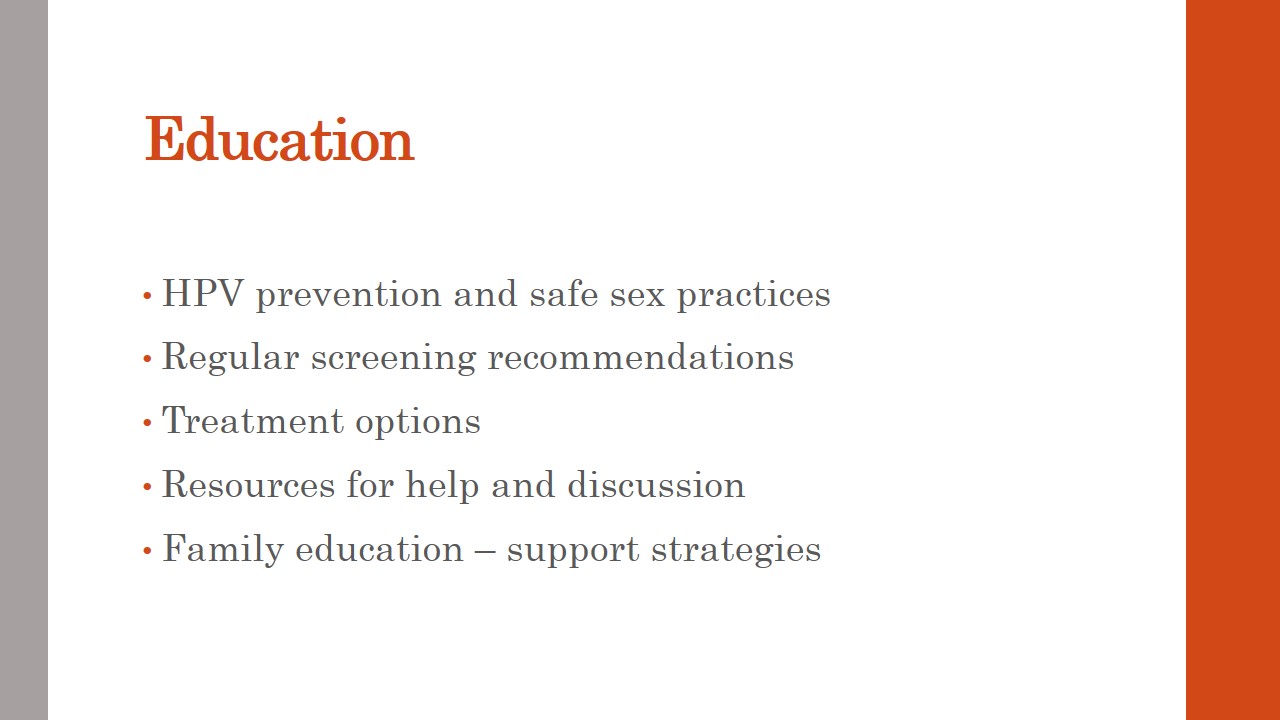
Outcomes
- Goals:
- No recurrence;
- No further progression;
- Follow-up care:
- Regular physical examination with tests;
- Prevention of recurrence and second cancer;
- Lifestyle changes – smoking cessation, physical activity, healthy diet (ACS, 2020).
Regardless of cancer’s stage, patients’ number of follow-up visits to the clinic increases. The outcomes of early treatment are that cancer does not recur – physical exams (with imaging and blood tests) are scheduled every 3 to 6 months for several years. Regular Pap tests are advised for women as well, although the cells may be taken from the vagina after the removal of the cervix. Some women may need to continue their radiation or chemotherapy to control the growth of their cancer. In this case, the treatment’s goal is to reduce symptoms, prolong the patient’s life, and stop or slow down cancer’s progression. Patients should also stay vigilant for the signs of second cancer – unrelated cancer types that may develop after the treatment.
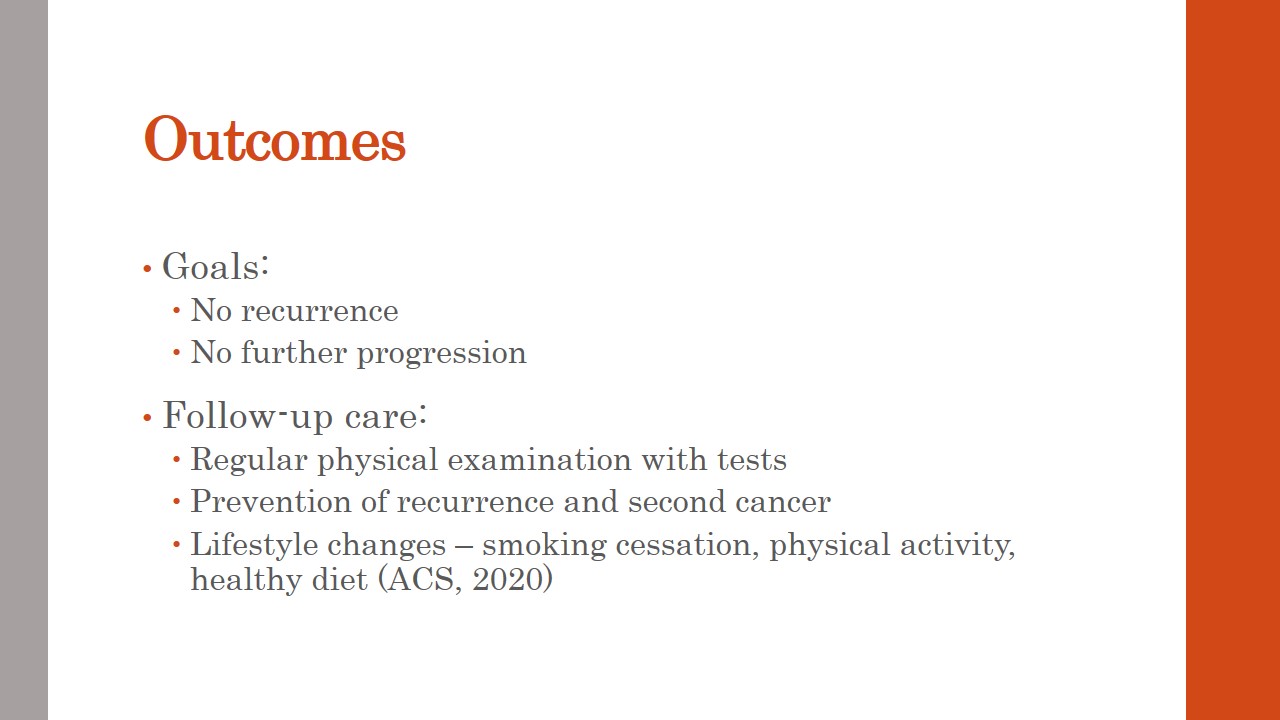
Discussion
- What strategies can increase the rate of HPV vaccination?
- What are the risks of performing screening tests?
- How can healthcare providers address health disparity related to higher cervical cancer rates worldwide?

References
American Cancer Society [ACS]. (2020). Living as a cervical cancer survivor. Web.
Curry, S. J., Krist, A. H., Owens, D. K., Barry, M. J., Caughey, A. B., Davidson, K. W., … Landefeld, C. S. (2018). Screening for cervical cancer: US Preventive Services Task Force recommendation statement. JAMA, 320(7), 674-686.
Marth, C., Landoni, F., Mahner, S., McCormack, M., Gonzalez-Martin, A., Colombo, N., & ESMO Guidelines Committee. (2017). Cervical cancer: ESMO Clinical Practice Guidelines for diagnosis, treatment and follow-up. Annals of Oncology, 28(suppl_4), iv72-iv83.
Musa, J., Achenbach, C. J., O’Dwyer, L. C., Evans, C. T., McHugh, M., Hou, L., … Jordan, N. (2017). Effect of cervical cancer education and provider recommendation for screening on screening rates: A systematic review and meta-analysis. PloS One, 12(9), e0183924.
National Cancer Institute [NCI]. (2020). Cancer stat facts: Cervical cancer. Web.
Small Jr, W., Bacon, M. A., Bajaj, A., Chuang, L. T., Fisher, B. J., Harkenrider, M. M., … Gaffney, D. K. (2017). Cervical cancer: A global health crisis. Cancer, 123(13), 2404-2412.